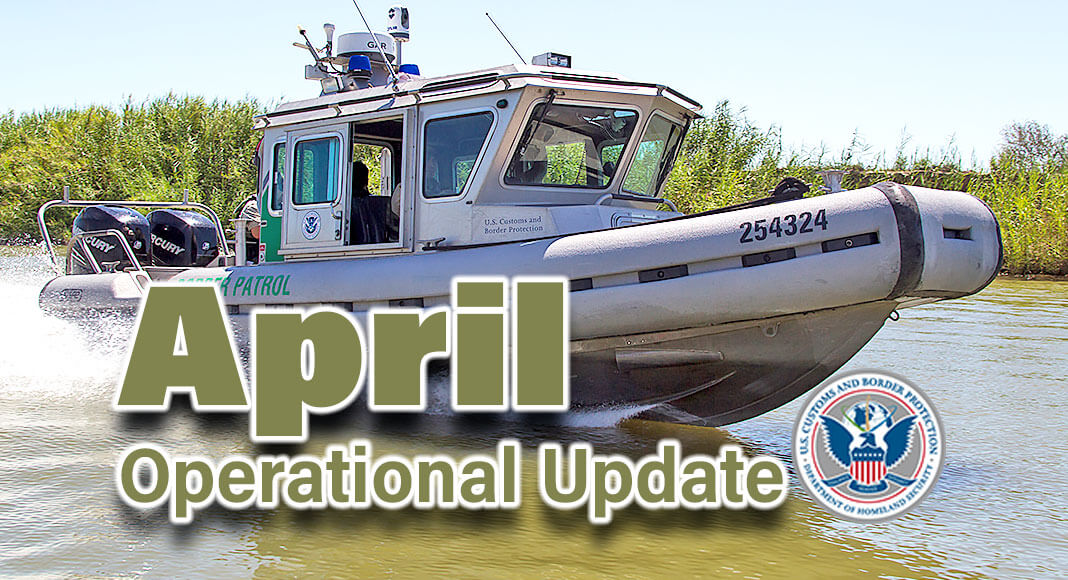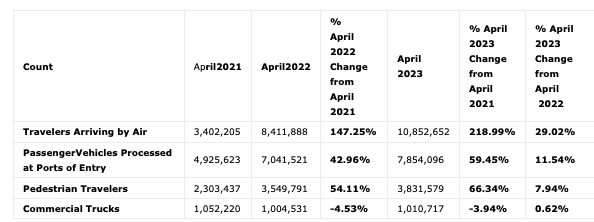
Texas Border Business
WASHINGTON, DC — U.S. Customs and Border Protection (CBP) released operational statistics for April 2023, which can be viewed online here.
“As part of our planning for the end of the Title 42 public health order, we have surged resources,technology, and personnel to safely and orderly manage challenges along the southern border – while at the same time, maintaining a persistent focus on our other missions to ensure national and economic security,” said CBP Acting Commissioner Troy A. Miller. “The CBP workforce -including the U.S. Border Patrol and the Office of Field Operations- have the experience and professionalism to continue to adapt to changing dynamics. Along with the support of personnel from across DHS and across the federal government, we will continue to meet the moment.”
CBP Southwest Border Enforcement Numbers for April 2023
CBP’s overall encounters along the southwest border in April 2023 totaled 211,401, up 10% from 191,956 in March 2023. Similarly, U.S. Border Patrol’s 182,114 encounters between ports of entry along the southwest border in April were up 12% over March. This increase in encounters from March to April is typical. However, in April 2023, southwest border encounter totals for CBP overall and Border Patrol decreased 11% and 10.5% respectively from April 2022.
Among CBP’s 211,401 encounters in April, single adult encounters increased by 5% compared to March, unaccompanied children decreased 7%, and family unit individuals increased by 28%.
- Over two-thirds (67%) of all southwest land border encounters were single adults, with 140,678 encounters in April, a 5% increase compared to March.
- 74,027 encounters, 35% of the total, were processed for expulsion under Title 42. 137,374 encounters were processed under Title 8.
- 65,406 encounters involving single adults (46% of all single adult encounters) were processed for expulsion under Title 42, with 75,272 processed under Title 8 (54% of all single adult encounters).
- 8,405 encounters involving family unit individuals (14% of all family unit individuals) were processed for expulsion under Title 42, with 50,559 processed under Title 8 (86% of all family unit individuals).
- In April 2023, there were 48,243 (23%) repeat encounters and 139,369 (66%) unique encounters. The number of unique individuals encountered in April 2023 was 139,369 compared to 119,053 in March 2023, a 17% increase in the number of unique individuals encountered the prior month.
- Of those, 23% involved individuals who had at least one prior encounter in the previous 12 months, compared to an average one-year re-encounter rate of 14% for FY2014-2019.
Unaccompanied Children
- Encounters of unaccompanied children decreased 7%, with 11,478encounters in April compared with 12,361 in March. In April, the average number of unaccompanied children in CBP custody was 500per day, compared with an average of 464 per day in March.
Family Unit individuals
- Encounters of family unit individuals increased by 28% from 45,891in March to 58,964 in April—which is a 32% decrease from the peak of 86,631 in August 2021.
During April 2023, 28,738 Cubans, Haitians, Nicaraguans, and Venezuelans (including immediate family members where applicable) were paroled into the country by CBP’s Office of Field Operations through the parole processes established for Venezuelans in October and expanded to the additional nationalities in January. Arrivals of noncitizens via these processes, which include careful vetting and require a supporter present in the Unites States, are a testament to the benefit of these lawful processes in promoting safe and orderly migration while reducing encounters along the southwest border.
Unique Southwest Border Encounters by Select Citizenships

Note: Unique encounters include persons not previously encountered in the prior 12 months.
Source: Office of Immigration Statistics analysis of CBP data.
CBP One App
From January 12, when the scheduling function was introduced, over 79,000 individuals have scheduled an appointment via the CBP One mobile application through the end of April. The top nationalities are Mexican, Venezuelan, and Haitian. In April, CBP processed over 22,000 individuals at ports of entry as exceptions to Title 42 based on an individual vulnerability assessment using the newly available functionality in the CBP One app. The high demand for these appointments has meant that not all individuals seeking appointments have been able to schedule them, but the transition of the exceptions process to CBP One allows more open access and has provided immediate benefits in reducing the exploitation of vulnerable persons seeking to present at ports of entry.
The large number of appointments scheduled via CBP One in recent months was made possible through the identification of process improvements and implementation of a series of software updates that fixed earlier reported technical difficulties. For example, CBP addressed reported challenges related to geolocation and error messages due to bandwidth issues with a third-party software for liveness. CBP One’s undocumented noncitizen scheduling functionality is now available in English, Spanish, and Haitian Creole. It is important, however, for users to approve location services when prompted in the application or they will be unable to schedule an appointment.
CBP Nationwide Total Encounters for FY23TD through April: 1,816,958
Ongoing Migration Management Efforts
CBP continues to enforce U.S. immigration law and apply consequences to those without a legal basis to remain in the United States. With the Title 42 public health Order no longer in place, CBP is processing individuals encountered at the border using its longstanding Title 8 authorities.
Under Title 8, those who attempt to enter the United States without authorization, and who are unable to establish a legal basis to remain in the United States, will be quickly removed. Individuals who have been removed under Title 8 are also subject to additional long-term consequences beyond removal from the United States, including bars to future immigration benefits.
DHS has been executing a comprehensive and deliberate strategy to secure our borders and build a safe, orderly, and humane immigration system. The strategy is based on six pillars: surging resources; increasing efficiency to reduce strain on the border; employing an aggressive consequence regime; bolstering the capacity of NGOs and partnering with state and local partners; going after cartels and smugglers; and working with our regional partners. This comprehensive plan leverages a whole-of-government approach to prepare for and manage the current and anticipated increases in encounters of noncitizens at our southwest border. Information about the plan can be found here. Recent border preparations in accordance with the plan are provided in DHS Fact Sheets here and here as well as in a press event Wednesday, May 10 here.
International Travel and Trade
One of CBP’s core mission objectives is to enhance the nation’s economic prosperity, including through the facilitation of lawful trade and travel. CBP continues to protect America’s national and economic security by facilitating legitimate trade while rigorously enforcing U.S. customs laws and regulations.

CBP tracks traveler numbers and wait times and continuously adjusts as needed to make the travel experience more efficient. Travelers can plan by doing the following:
- Have a valid Western Hemisphere Travel Initiative document, such as a passport, Trusted Traveler Program card, or Enhanced Tribal Card.
- Possess proof of an approved COVID-19 vaccination as outlined on the CDC website.
- Verbally attest to their travel intent and COVID-19 vaccination status.
- Be prepared to present any documents requested by the CBP officer.
Trade Stats/Seizures – Protecting the American Consumer
CBP works diligently with the trade community and port operators to ensure that merchandise is cleared as efficiently as possible. CBP works with the trade community to strengthen international supply chains and improve border security. There are several programs by which CBP works with importers, carriers, consolidators, licensed customs brokers, and manufacturers to advance information about the shipments and expedite the inspection process at the ports of entry. CBP is available to conduct exams and is ready and willing to expand hours of operations if necessary to meet the growing demand for imported goods.
In April 2023, CBP processed more than 2.6 million entry summaries valued at more than $257 billion, identifying estimated duties of nearly $6.5 billion to be collected by the U.S. government. In April, trade via the ocean environment accounted for more than 42% of the total import value, followed by air, truck, and rail.
In April 2023, CBP identified 377 shipments valued at more than $159 million for further examination based on the suspected use of forced labor, and which may be subject to a Withhold Release Order, Forced Labor Finding, or the Uyghur Forced Labor Prevention Act’s rebuttable presumption, and prohibited importation into the United States under 19 U.S.C. § 1307.
Intellectual property rights violations continue to put America’s innovation economy at risk. Trade in counterfeit and pirated goods threaten the competitiveness of U.S. businesses, the livelihoods of American workers, and the health and safety of consumers.
In April 2023, CBP seized 1,864 shipments that contained counterfeit goods valued at more than $2.7 billion.
CBP completed 33 audits that identified $136 million in duties and fees owed to the U.S. government, stemming from goods that had been improperly declared in accordance with U.S. trade laws and customs regulations. CBP collected over $2 million of this identified revenue and from previous fiscal years’ assignments.
Drug Seizures
CBP’s fentanyl seizures increased 14% in April compared to March. Last month, DHS announced that in its first month, Operation Blue Lotus and the complementary Operation Four Horseman seized more than 5,000 pounds of fentanyl.
CBP’s fentanyl seizures have increased more than 400 percent since fiscal year 2019 and our fiscal year 2023 seizures of fentanyl have already surpassed the fiscal year 2022 seizure total. CBP seized more than 17,000 pounds of fentanyl from October 2022 through April 2023 as compared with about 6,600 pounds from October 2021 through April 2022.
CBP officers, Border Patrol agents, and Air and Marine Operations agents continue to interdict the flow of illicit narcotics across the border. Nationwide, drug seizures (Cocaine, Methamphetamine, Heroin, Fentanyl, and Marijuana) by weight decreased 35% in April compared to March. More than 90% of fentanyl is trafficked in cars and trucks through Ports of Entry.
Additional CBP drug seizure statistics can be found here.
Agriculture Stats/Seizures – Securing American Agriculture
In April 2023, CBP agriculture specialists helped protect America’s agriculture, natural resources, and economic prosperity.
- CBP issued 5,422 emergency action notifications for restricted and prohibited plant and animal products entering the United States.
- CBP conducted 93,470 positive passenger inspections and issued 698 civil penalties and/or violations to the traveling public for failing to declare prohibited agriculture items.














